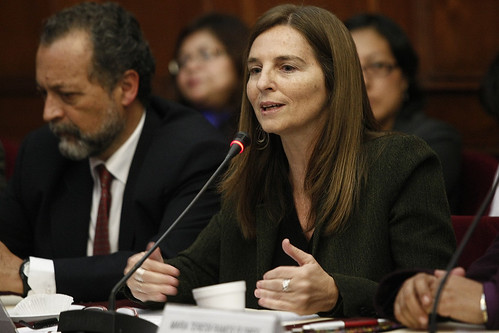14th February 2013 Lima, Peru
Peru: Violence against women persists
By: Andrea Querol. Executive Director and Founder of Capital Humano y Social Alternativo.

When you work on areas related to human rights, you do not need to dig deep to realise that women (as well as children and teenagers) are often the most vulnerable in our societies. Their rights are violated constantly; not just during times of war and armed conflict, but in times of peace and in the everyday course of their lives.
It is not enough at the end of an armed conflict to report that dozens or hundreds of women have been violated. This is not the solution, it does not fix the damage that has already been done to the victims, nor –as history has shown – does it stop it from happening time and again in successive armed conflicts. This happens all over the world, on every continent, on every street and neighbourhood, and although the crime is recorded, the victim seldom receives compensation and rarely sees justice done.
In Peru we are no strangers to this reality – the Truth & Reconciliation Commission’s 2003 report revealed that during our internal armed conflict, countless cases of sexual violence were committed, between 1984 and 1990. It is estimated that at least 83% of the perpetrators were state agents and 11% were members of subversive groups.
Thirteen years have passed since the end of our armed conflict yet during peacetime, when it would be natural to expect that the rights of citizen be respected; complaints of domestic violence and sexual abuse related to women are surprisingly frequent – between 2006 and 2010 the Ministry of Woman and Vulnerable Populations emergency women’s centres assisted 192,000 victims of sexual or domestic violence, 88% of whom were women. In 2012, 39,400 cases had been filed by November.
Unfortunately adult women are not the only victims. Data from the Public Ministry’s Observatory reveals that on average, 63 of every 100 victims of rape in Lima and Callao alone are minors. And in 2007, the Women and Social Development Ministry reported there were 10,500 cases of underage sexual exploitation nationally.
Violence is a fact of life and will continue to be so as long as we fail to curb our aggressive instincts. One of the ways in which collective and individual violence unite and empower each other is in the trafficking of humans for sexual exploitation.
In Peru, human trafficking for sexual exploitation often wears the face of a young woman, frequently underage, who despite her origins is sold and abused in informal mining camps, urban entertainment centres or any establishment provided for sexual commerce. Such cases of human exploitation are permitted by a complacent society and a state that, despite the progress made at the national level, is still weak at a local and regional level.
The small number of cases prosecuted and general lack of awareness in the population that these women are victims is worrying. The belief that women suffer abuse because they want to, or even worse, that it happens because they deserve it is still common.
A macho culture persists too, arguing that women should serve men and that they are willing (and have a deep desire) to be dominated, have men take control, and even, abuse them through acts of violence or sexual assault. In the case of human trafficking, this macho behaviour is enhanced and aggravated by the objectification of women. On the one hand it gives the traffickers the belief that they’re dealing with a profit producing resource rather than a human being; and on the side of the client, the absolute apathy towards the feelings of the women they use.
Human trafficking, particularly of women, will not disappear. In recent years, despite of the efforts of many organisations and states globally, incidences of human trafficking have increased, and like drug trafficking, it flourishes thanks to corruption and inefficiency of the organisations that should be fighting it.
Key to success in the fight against all forms of violence against women, and human trafficking in particular, is to increase awareness at all levels – to educate citizens and public officials and encourage them to acknowledge their duties and to implement their obligations according to the law.
Finally, we should exert pressure on citizens to unmask the issue and put pressure on those that use the services of exploited minors and women to shame them. Acts of domestic and sexual violence will always be the acts of a coward, making it easier to exert social pressure to change behaviours and educate those that commit such acts, helping them to recognise the rights of women to a life free of exploitation and violence.
*Capital Humano y Social Alternativo is an organisation focused on the defence of human rights that particularly affect women and children – notably situations of human trafficking, and sexual and labour exploitation.
Human trafficking should be cancelled and appropriate measure should be taken against the offenders.